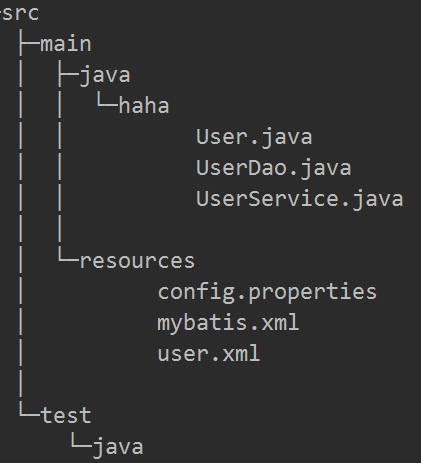一、创建Maven项目
在pom.xml中,添加mybatis依赖,mysql-jdbc依赖,把编译版本改为1.8
你问,为啥mybatis不会自动依赖mysql-jdbc,需要手动写明?答:因为mysql驱动是通过字符串动态加载的,这是一种“动态依赖”,Maven只能推导出“静态依赖”。“动态依赖”是一种更加灵活的依赖。
Maven默认的Java版本是1.6,无法使用lambda表达式(1.8)和钻石运算符(1.7)。
代码片段:pom.xml
<?xml version="1.0" encoding="UTF-8"?>
<project xmlns="http://maven.apache.org/POM/4.0.0"
xmlns:xsi="http://www.w3.org/2001/XMLSchema-instance"
xsi:schemaLocation="http://maven.apache.org/POM/4.0.0 http://maven.apache.org/xsd/maven-4.0.0.xsd">
<modelVersion>4.0.0</modelVersion>
<groupId>wyf</groupId>
<artifactId>xqweb</artifactId>
<version>1.0-SNAPSHOT</version>
<dependencies>
<!-- https://mvnrepository.com/artifact/org.mybatis/mybatis -->
<dependency>
<groupId>org.mybatis</groupId>
<artifactId>mybatis</artifactId>
<version>3.4.4</version>
</dependency>
<!-- https://mvnrepository.com/artifact/org.springframework/spring-jdbc -->
<!-- https://mvnrepository.com/artifact/mysql/mysql-connector-java -->
<dependency>
<groupId>mysql</groupId>
<artifactId>mysql-connector-java</artifactId>
<version>6.0.6</version>
</dependency>
</dependencies>
<build>
<plugins>
<plugin>
<groupId>org.apache.maven.plugins</groupId>
<artifactId>maven-compiler-plugin</artifactId>
<configuration>
<source>1.8</source>
<target>1.8</target>
<encoding>utf8</encoding>
</configuration>
</plugin>
</plugins>
</build>
</project>创建好了pom.xml,就可以开始编码了。最终的目录结构如下,下面让我们来一步一步创建文件。
二、配置Mybatis
代码片段:mybatis.xml
<?xml version="1.0" encoding="UTF-8" ?>
<!DOCTYPE configuration
PUBLIC "-//mybatis.org//DTD Config 3.0//EN"
"http://mybatis.org/dtd/mybatis-3-config.dtd">
<configuration>
<properties resource="config.properties">
</properties>
<environments default="development">
<environment id="development">
<transactionManager type="JDBC"/>
<dataSource type="POOLED">
<property name="driver" value="${driver}"/>
<property name="url" value="${url}"/>
<property name="username" value="${username}"/>
<property name="password" value="${password}"/>
</dataSource>
</environment>
</environments>
<mappers>
<mapper class="haha.UserDao"/>
<mapper resource="user.xml"/>
</mappers>
</configuration>代码片段:config.properties
username=root
password=haha
driver=com.mysql.jdbc.Driver
url=jdbc:mysql://localhost:3306/test?serverTimezone=Asia/Shanghai把配置信息跟mybatis.xml分开的好处是:更清晰。mybatis属于代码区,config.properties改起来比较简单。
三、创建实体类User
User有三个属性:name,age和id,重写toString()方法便于调试。
package haha;
public class User {
String name;
Integer age;
Integer id;
public User(){}
public User(String name,int age){
this.name=name;
this.age=age;
}
public String getName() {
return name;
}
public void setName(String name) {
this.name = name;
}
public Integer getAge() {
return age;
}
public void setAge(Integer age) {
this.age = age;
}
public Integer getId() {
return id;
}
public void setId(Integer id) {
this.id = id;
}
@Override
public String toString() {
return String.format("(id:%d,name:%s,age:%d)", id, name, age);
}
}相应的,在数据库中建立一个表user
CREATE TABLE `user` (
`id` int(11) NOT NULL AUTO_INCREMENT,
`name` varchar(10) DEFAULT NULL,
`age` int(11) DEFAULT NULL,
PRIMARY KEY (`id`)
) ENGINE=InnoDB AUTO_INCREMENT=119 DEFAULT CHARSET=utf8mb4四、实现UserDao接口
UserDao接口有两个功能:插入、查询全部。
package haha;
import org.apache.ibatis.annotations.Insert;
import org.apache.ibatis.annotations.Param;
import org.apache.ibatis.annotations.Select;
import org.apache.ibatis.annotations.SelectKey;
import java.util.List;
public interface UserDao {
@Insert("insert into user(name,age) value(#{name},#{age})")
int insert_withoutPrimaryKey(@Param("name") String name, @Param("age") int age);
int insert_useGeneratedKey(@Param("user") User user);
int insert_selectKey(@Param("user") User user);
@Insert("insert into user(name,age) value(#{user.name},#{user.age})")
@SelectKey(statement = "select last_insert_id()", keyProperty = "user.id", before = false, resultType = int.class)
int insert_selectKeyAnotation(@Param("user") User user);
@Select("select*from user")
List<User> getAll();
}Mybatis写SQL语句有两种方式:1、使用注解;2、使用xml
对于比较长的SQL语句放在xml中,对于比较短的SQL语句放在注解中
在上面定义的UserDao中,insert_userGeneratedKey()和insert_selectKey()两个函数没有给出对应的SQL语句,需要在xml文件中进行定义。
代码片段:user.xml
<?xml version="1.0" encoding="UTF-8" ?>
<!DOCTYPE mapper PUBLIC "-//mybatis.org//DTD Mapper 3.0//EN" "http://mybatis.org/dtd/mybatis-3-mapper.dtd">
<mapper namespace="haha.UserDao">
<insert id="insert_useGeneratedKey" parameterType="haha.User"
useGeneratedKeys="true" keyProperty="user.id">
insert into user set id=#{user.id},name=#{user.name},age=#{user.age}
</insert>
<insert id="insert_selectKey" parameterType="haha.User">
<selectKey keyProperty="user.id" keyColumn="id" order="AFTER" resultType="int">
SELECT last_insert_id()
</selectKey>
insert into user(name,age) VALUE (#{user.name},#{user.age})
</insert>
</mapper>五、万事俱备,只欠东风
编写一个UserService类测试一下
package haha;
import org.apache.ibatis.io.Resources;
import org.apache.ibatis.session.SqlSession;
import org.apache.ibatis.session.SqlSessionFactory;
import org.apache.ibatis.session.SqlSessionFactoryBuilder;
import java.io.IOException;
import java.io.InputStream;
import java.util.List;
public class UserService {
public static void main(String[] args) throws IOException {
String resource = "mybatis.xml";
InputStream inputStream = Resources.getResourceAsStream(resource);
SqlSessionFactoryBuilder builder = new SqlSessionFactoryBuilder();
SqlSessionFactory factory = builder.build(inputStream);
SqlSession session = factory.openSession();
UserDao dao = session.getMapper(UserDao.class);
//使用默认主键
int affectedRows = dao.insert_withoutPrimaryKey("张三", 25);
System.out.println(affectedRows);
//使用useGeneratedKey,将主键注入到user.id中
User u = new User("张三", 17);
affectedRows = dao.insert_useGeneratedKey(u);
System.out.println(affectedRows + " " + u.getId());
//使用selectKey执行在插入之前或之后执行查询语句
affectedRows = dao.insert_selectKey(u);
System.out.println(affectedRows + " " + u.getId());
//使用selectKey注解的方式
affectedRows = dao.insert_selectKeyAnotation(u);
System.out.println(affectedRows + " " + u.getId());
session.commit();
List<User> a = dao.getAll();
a.forEach(System.out::println);
}
}六、insert()函数返回值
如下代码,insert()函数的返回值为int类型,表示affectedRows,即受影响的行数,如果成功插入返回1,如果不成功插入,返回0。对于一切写操作(insert,update,delete),返回值都是affectedRows。
@Insert("insert into user(name,age) value(#{name},#{age})")
int insert(@Param("name") String name, @Param("age") int age);七、关于@SelectKey
关于insert()有一种需求很常见:如何确定插入数据的主键。对于MySQL中的自增类型主键,无需提供主键可以直接插入。还是以insert()函数为例,这个SQL语句没有提供主键,主键是自增类型可以自动生成。
@Insert("insert into user(name,age) value(#{name},#{age})")
int insert(@Param("name") String name, @Param("age") int age);下面介绍一个重要注解@SelctKey(statement="SQL语句",keyProperty="将SQL语句查询结果存放到keyProperty中去",before="true表示先查询再插入,false反之",resultType=int.class)
其中:
- statement是要运行的SQL语句,它的返回值通过resultType来指定
- before表示查询语句statement运行的时机
- keyProperty表示查询结果赋值给代码中的哪个对象,keyColumn表示将查询结果赋值给数据库表中哪一列
- keyProperty和keyColumn都不是必需的,有没有都可以
- before=true,插入之前进行查询,可以将查询结果赋给keyProperty和keyColumn,赋给keyColumn相当于更改数据库
- befaore=false,先插入,再查询,这时只能将结果赋给keyProperty
- 赋值给keyProperty用来“读”数据库,赋值给keyColumn用来写数据库
- selectKey的两大作用:1、生成主键;2、获取刚刚插入数据的主键。
- 使用selectKey,并且使用MySQL的last_insert_id()函数时,before必为false,也就是说必须先插入然后执行last_insert_id()才能获得刚刚插入数据的ID。
注意:
- 该注解相当于XML配置中的
<selectKey>的标签 - 与注解
@Insert,@InsertProvider,@Updateor@UpdateProvider搭配使用。在其他方法上将被忽略。 - 如果你指定了一个
@SelectKey注解,然后Mybatis将忽略任何生成的key属性通过设置@Options,或者配置属性。 - 属性: statement是要执行的sql语句的字符串数组, keyProperty是需要更新为新值的参数对象属性, before可以是true或者false分别代表sql语句应该在执行insert之前或者之后, resultType是keyProperty的Java类型, statementType是语句的类型,取Statement, PreparedStatement和CallableStatement对应的STATEMENT, PREPARED或者CALLABLE其中一个,默认是PREPARED。
1、举一个before=true的例子,新插入数据的id是当前表中行的个数
当before=true,可以通过SQL语句来填充insert语句中的某个参数,这个参数的名称可以通过keyProperty来指明。
@Insert("insert into user value(#{id},#{name},#{age})")
@SelectKey(statement="select count(1)from user", keyProperty="id", before=true, resultType=int.class)
int insert(@Param("name") String name, @Param("age") int age);这个函数返回值是affectedRows,也就是插入成功返回1,插入失败返回0。
以上这段代码有一个大大的隐患,万万不能用在生产环境中。这个隐患就是:不能通过count()来确定id,多线程情况下有可能产生冲突。解决方案:可以使用UUID作为主键。
2、before=false的情况
注意keyProperty不能使基本类型,因为那样赋值之后就找不到了(相当于传值)
注解的方式
@Insert("insert into user(name,age) value(#{user.name},#{user.age})")
@SelectKey(statement = "select last_insert_id()", keyProperty = "user.id", before = false, resultType = int.class)
int insert_selectKeyAnotation(@Param("user") User user);XML的方式
<insert id="insert_selectKey" parameterType="haha.User">
<selectKey keyProperty="user.id" keyColumn="id" order="AFTER" resultType="int">
SELECT last_insert_id()
</selectKey>
insert into user(name,age) VALUE (#{user.name},#{user.age})
</insert>3、在Oracle中使用SelectKey生成主键,通常是“先查询得到主键,再进行插入”
DUAL表是Oracle中的神奇的表
使用序列作为主键
<insert id="insertSelective" parameterType="com.zehin.vpaas.base.domain.SfyHazardAnalysis">
<selectKey resultType="java.lang.Integer" order="BEFORE" keyProperty="hazardId">
SELECT SEQUENCE_1.NEXTVAL FROM DUAL
</selectKey>
insert into SFY_HAZARD_ANALYSIS
<trim prefix="(" suffix=")" suffixOverrides=",">
HAZARD_ID,
<if test="hazardTime != null"> HAZARD_TIME,</if>
<if test="hazardTitle != null"> HAZARD_TITLE, </if>
<if test="hazardMeasure != null"> HAZARD_MEASURE, </if>
<if test="buildId != null"> BUILD_ID, </if>
</trim>
<trim prefix=" values(" suffix=")" suffixOverrides=",">
#{hazardId,jdbcType=INTEGER},
<if test="hazardTime != null">#{hazardTime,jdbcType=VARCHAR},</if>
<if test="hazardTitle != null"> #{hazardTitle,jdbcType=VARCHAR}, </if>
<if test="hazardMeasure != null"> #{hazardMeasure,jdbcType=VARCHAR}, </if>
<if test="buildId != null"> #{buildId,jdbcType= INTEGER}, </if>
</trim>
lt;/insert>使用GUID作为主键
<insert id="insertUser" parameterType="com.danny.mybatis.po.User">
<selectKey keyProperty="userId" order="BEFORE" resultType="java.lang.Integer">
select SYS_GUID() as userId from DUAL
</selectKey>
insert into T_USER(userId,userName,birthday,sex,address) values (#{userId},#{userName},#{birthday},#{sex},#{address}) </insert>4、使用useGeneratedKeys
<insert id="insert" parameterType="Spares"
useGeneratedKeys="true" keyProperty="id">
insert into spares(spares_id,spares_name,
spares_type_id,spares_spec)
values(#{id},#{name},#{typeId},#{spec})
</insert> <insert id="insertUser" useGeneratedKeys="true" keyColumn="id">
insert into user(name,age) VALUE (#{name},#{age})
</insert>八、获取刚刚插入数据的主键
除了使用selectKey的方式获取刚刚插入数据的主键,还有以下方案:
1、如果是MySQL,可以用select last_insert_id()语句获取新插入数据的主键。
2、如果主键类型是UUID,可以直接在代码中生成主键进行插入,这样就不需要从数据库中读取主键了,主动权掌握在代码手中。
九、参考资料
转载于:https://www.cnblogs.com/weiyinfu/p/6835301.html